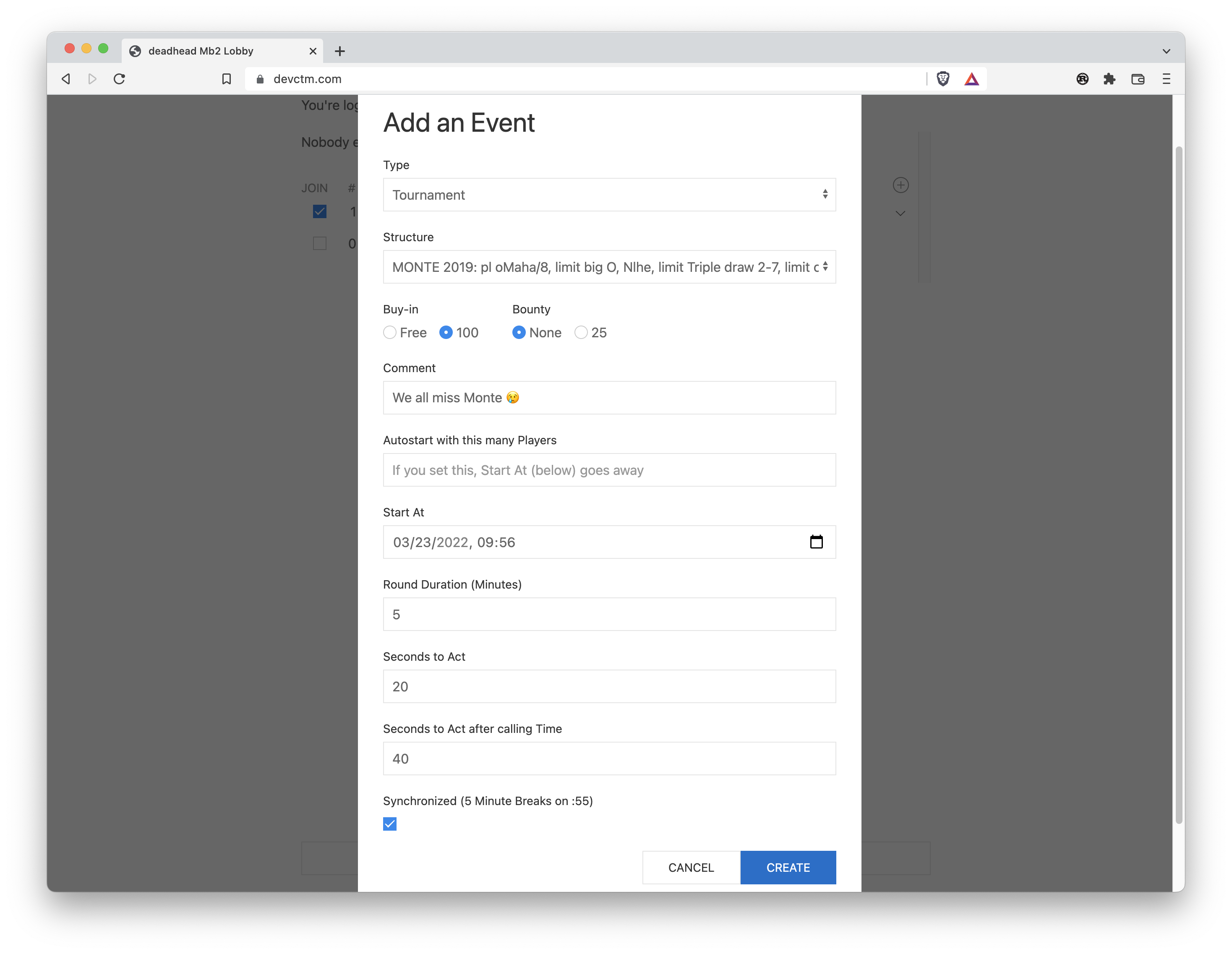Creating Tournaments
In the lobby, if you click on the white plus small icon, you get a dialog that looks something like:

Type
For now, just leave the Type as Tournament.
Structure
The Structure attribute is a pull-down menu from one of more than a hundred pre-existing tournament structures. Currently you can not create your own structure.
Buy-in
Tournaments that are created for testing or demo purposes should be Free, since free tournaments don’t affect anyone’s standings. Tournaments where people are expected to play well should have a 100 buy-in if for no other reason than to make it clear that the participants will be taking the tournament seriously.
Bounty
If the 25 radio button is selected, then sufficient Fun Money is
deducted from the prize pool so that an award of FM 25 can be made to
the player who busts another player. If N people are in a tournament,
then N-1 bounties will be paid out by the time the tournament ends.
Comment
Adding a comment is optional. If you add a comment, it will show up when people hover over the tournament structure in the listing of upcoming tournaments.
Autostart
If you put a number in the Autostart field, then the tournament will
start automatically once that number of participants join. In general,
you should not create an autostart tournament unless you think there
are enough people in the lobby to sign up within five or ten minutes,
otherwise you may find that nobody will sign up because it will be too
hard to predict when it will start.
If you put a number in Autostart, the Start At field will be removed.
You can only either start by Autostart or Start At, not both.
Start At
Start At is in the same timezone as upcoming tournaments are displayed in. That’s whatever your browser thinks your timezone is. The first time you bring up the “Add a Tournament” dialog, “Start At” is pre-populated with a value that is ten minutes into the future. However, after that, the dialog simply remembers whatever value was in that field previously.
If the lobby observes that you’ve won a tournament, then the next time you create a tournament, Start At will be pre-populated with the same starting time as the tournament you won, but be on the following day. This helps people who win the evening or night tournaments, because the convention is to let the winner choose the tournament for the following day.
Round Duration
Round Duration (Minutes) is in essence a scaling factor. In most tournaments, all rounds are the same length. When create a new tournament and specify the round duration, what you’re really doing is saying how long you want the first round to be. If any rounds have a different duration from the duration of the first round, they’ll be scaled.
So, if there’s a structure where the odd numbered rounds are 20 minutes and the even numbered rounds are 30 minutes, if you specify Round Duration as 5 minutes, then you’ll have a tournament where the odd numbered rounds are 5 minutes and the even ones are 7.5 minutes.
The TOC (Tournament of Champions) style format has a 15 minute Hold’em first round, an 18 minute Stud second round and a 22 minute Omaha/8 third round. So, if “Round Duration (Minutes)” is set to 5, then the second round will be 6 minutes and the third round will be seven minutes, twenty seconds long.
For a dozen or so players, five minute rounds for most structures results in a tournament that finishes in about an hour and a half.
Seconds to Act
Seconds to Act is how much time a player gets to act before being sent to vacation. No, 999 is not a reasonable number of “Seconds to Act”. Typically we use 45 there and that’s the default when this dialog comes up.
A player may call time to get more time to act. There currently is no limit on how many times a player can call time. Calling time resets the number of seconds to act (it does not add to the number of seconds to act). So, if “Seconds to Act after calling Time” is set to 60, calling time will mean that the player must act within 60 seconds regardless of how much time to act the player had remaining.
Synchronized Breaks
Schedules have breaks built into them, and like Round Duration, they scale based on the same ration of the “Round Duration (Minutes)” setting to the duration of the first level in the structure. That can result in breaks that would be too short were it not for the “Minimum Break Duration in Minutes” setting. However, the duration of a break is like the duration of a round in that it can start in the middle of a hand. The players who are still in the hand still need to finish the hand.